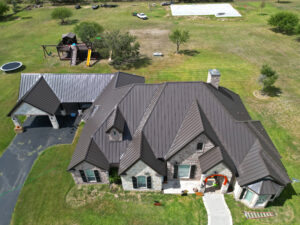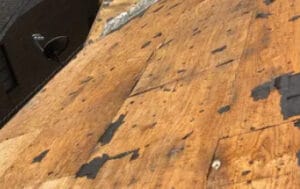Standing Seam and Snap Lock Metal Roofing Cost Factors

Existing Roof Layout
The cost of the roof layout can vary significantly depending on the complexity of the roof surface. We consider several factors when determining the price. For instance, we take into account whether the roof has a solid deck or if there are numerous valleys, hips, wall flashings, and ridge areas. If the roof has multiple pitches, gables, dormers, or other intricate details, it will drive up the cost. This is because it requires more fabrication hours to custom make the necessary trim and also takes additional time to install. So, the more intricate the roof, the more involved the process, which can affect the overall cost.

Existing Materials
The type of existing roofing material being used is an important factor that influences the tear-off cost. Removing an asphalt shingles roof is generally less labor-intensive compared to a clay tile roof. It’s worth noting that landfill costs for disposing of construction materials are continually increasing. Most landfills charge fees based on weight, typically ranging from $200 to $400 depending on the specific county regulations. As a result, it’s crucial to consider these factors when estimating the overall tear-off expenses.

Type of Roof System Selected
The choice of roofing system plays a significant role in determining the cost of a metal roof. Factors such as the type of system, whether it’s an exposed fastener system, stone coated metal, or a hidden fastener system, all have their unique cost drivers. For this reason, the overall cost of the metal roof can vary considerably depending on the specific system chosen. It’s important to consider these factors when evaluating the pricing of a metal roof installation.

Metal Type Used
Different types of metal, including aluminum, galvalume, and galvanized, can be used as roofing materials. The choice of metal affects the fabrication process and can impact the overall cost of the roofing system. For instance, certain metals like copper may require specialized formers for manufacturing, which can increase the fabrication expenses. Therefore, it’s essential to consider the specific metal type when evaluating the cost and fabrication requirements for a metal roofing system.

Panel Dimensions
The length of the roof panels is another factor that can impact the cost of certain types of roof panels. If the panels exceed a certain length, it can drive up the cost due to transportation limitations. Additionally, working with longer panel lengths is more labor-intensive and requires roofing crews with a larger number of people to handle them effectively. Therefore, when dealing with longer panels, it’s important to consider both the transportation limitations and the need for a skilled and adequately sized roofing crew, which can affect the overall cost of the project

Panel Color
The cost of pigments can vary depending on the type used. Contractors typically offer a base price for a pallet of a dozen Basic Colors, while Premium or Metallic Colors may incur additional charges. The availability and stock of colors processed by metal manufacturers can also influence costs. Ordering a special color that needs to be done on demand may result in higher expenses compared to choosing from the available stock colors. It’s important to consider these factors when selecting pigments for your project, as they can impact the overall cost.
Metal Roof Project Location
Another major factor that will drive the cost of a metal roof is the area where it will be installed. Some areas suffer from a shortage of skilled workers and high demand, which increases the cost of metal roof installation.
Additionally, the geographical location will also need to be considered. A metal roof project near a body of water will require more specialized care to prevent it from warping or becoming damaged than a metal roof in a dryer climate.
Some location designated as high wind areas such as coastal cities will require the roofing company to comply with specific building codes that usually drive up labor cost.

Metal Roofing Brownsville TX
Snap Lock Metal Roofing Prices
The cost of Snaplock Panels is primarily influenced by the price of metal coils. Due to the impact of COVID-19, the production of metal coils has been delayed, resulting in longer waiting times for core materials required for manufacturing Snap Lock Metal Panels and trim.
In addition, the rise in gas prices has contributed to the increased manufacturing costs and delivery expenses. Many regional and local suppliers have implemented significant price hikes over the past two years, affecting the square foot cost of materials. The combination of limited material availability and labor shortages has contributed to the overall increase in cost for Metal Roof Systems.
It’s important to remember that investing in a Metal Roof System entails a higher initial investment but offers durability for 50 years or more. At Marva Roofing, we strive to provide the most competitive price ranges in our industry for metal roof installations. Through efficient project management, streamlined labor practices, and minimizing waste during the manufacturing process, we achieve significant cost savings that we pass on to our customers for their installation expenses.
Other factors affecting Metal Roofing Cost are the actual design of your roof and material selection.
- Time of year of installation will also affect the cost of your metal roofing. For example, having a new roof installed or repaired during hurricane season will always cost more than at other times because of the sheer demand.
- Snaplock Metal Roofing Panels manufactured with a nail strip will require additional materials for manufacturing, resulting in slightly less panel coverage overall.



